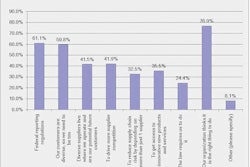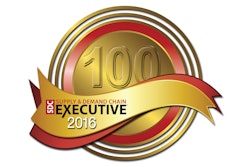
Virtually all diversity suppliers meet or exceed expectations, and top corporate performers in supplier diversity experience no loss in efficiency, according to new research from The Hackett Group, Inc. In addition, they see improved quality and often extract other benefits, including increased market share and access to new revenue opportunities. The research challenges the attitude of many business leaders, who worry that dedicating resources to supplier diversity will divert attention from other strategic activities.
To truly unlock the full potential benefits of supplier diversity efforts, The Hackett Group recommends that companies consider expanding beyond traditional goals such as complying with regulations. Top performers in supplier diversity recognize the value of objectives such as the ability to gain access to new markets and improve supplier partnerships. In addition, companies should look beyond basic measures such as the percentage of spend with diverse suppliers, and calculate the true value of supplier diversity by using more sophisticated performance metrics such as satisfaction levels and other secondary metrics that are aligned to long- and short-term plans and objectives.
The research also shows that companies with top-performing supplier diversity programs focus on several areas to make the most of their efforts, and go beyond the basics. These companies develop supplier partnerships, mentor local suppliers, collaborate with suppliers on product innovation, and share their experiences with other companies. They use supplier diversity as a reputation-builder to help increase market share and retain talent, and rely on social media to develop customer and brand awareness. They also actively educate internal stakeholders on the value of supplier diversity, and interact with local communities of suppliers and consumers to better understand the market, establish relationships and share supplier diversity goals.
While most supplier diversity programs have a domestic focus, The Hackett Group’s research found that more than 40 percent of all global companies with a U.S. supplier diversity program plan to expand globally within the next two to three years. The Hackett Group recommends that companies manage U.S. and global programs as a single initiative, where appropriate. Partnering with corporate diversity groups, which manage workforce diversity, also is highly advisable, as is working with third parties that can help companies connect with diverse suppliers.
“Supplier diversity is evolving from a check-the-box corporate social responsibility requirement to a strategic enabler providing access to new and innovative products and increased market share in new and developing communities,” says Laura Gibbons, director of The Hackett Group Research. “Top-performing organizations are taking advantage of this opportunity, and applying the tenets of social diversity to new areas such as supplier partnering, reputation management and global expansion with exceptional results.”
Gibbons did, however, caution that there are challenges that need to be overcome.
“It can be difficult to obtain the necessary support to invest in supplier diversity programs,” says Gibbons. “Business leaders often worry that dedicating resources to this will impact procurement savings or even quality. But our research clearly shows that this is not true. Top performers are not seeing losses in efficiency, and quality often improves. Overall, the risks to focusing on supplier diversity are quite low, and the potential upside is significant. In fact, up to 10 percent of sales come with supplier diversity requirements, suggesting that the lack of such a program can even result in lost revenue.”
An example of company already doing this well is IBM.
“At IBM, we’ve been leading the way in corporate supplier diversity efforts for nearly 50 years,” says Michael Robinson, program director at Global Supplier Diversity, IBM. “Today, we’re the only company that we know of who has a diverse supplier requirement in every country where we operate worldwide. We count on our supplier network, and ask the same thing of our women- and minority-owned suppliers as we do of our majority suppliers—that they help us provide value to the customer, strengthen our brand, understand our markets and identify what’s coming next in the world of technology. It’s in our best interest to find the best suppliers, and a focus on supplier diversity is an important part of how we do that.”
According to Jillnell Joiner, senior supplier diversity manager, American Red Cross, the American Red Cross has become very focused on expanding its supplier diversity efforts over the past few years.
“Communication has become a key best practice for us,” she notes. “We want to make sure suppliers, including minorities, women and veterans, understand that the door is open.
“Some things are simple. If a supplier reaches out to us, we respond, no matter what,” continues Joiner. “Last year we also did workshops in 15 states across the country, in partnership with the National Minority Supplier Development Council, to help suppliers understand the extent of our supplier diversity efforts, and how best to do business with us. These workshops have been a great asset for us.”
According to Elizabeth A. Vazquez, CEO and co-founder of WEConnect International, “Some of the most successful supplier diversity and inclusion programs come from companies that have diversity and inclusion in their DNA. They are making strategic investments in the communities they serve not only in the U.S., but around the world. Global corporations must be committed to utilizing the world’s best suppliers. Smart companies will make a conscious effort to identify underutilized suppliers in every market that can bring value, including businesses owned by women, ethnic minorities, people with disabilities, members of the LGBT community, and other groups.”


![Pros To Know 2026 [color]](https://img.sdcexec.com/mindful/acbm/workspaces/default/uploads/2025/08/prostoknow-2026-color.mduFvhpgMk.png?auto=format%2Ccompress&bg=fff&fill-color=fff&fit=fill&h=100&q=70&w=100)







![Pros To Know 2026 [color]](https://img.sdcexec.com/mindful/acbm/workspaces/default/uploads/2025/08/prostoknow-2026-color.mduFvhpgMk.png?ar=16%3A9&auto=format%2Ccompress&bg=fff&fill-color=fff&fit=fill&h=135&q=70&w=240)






